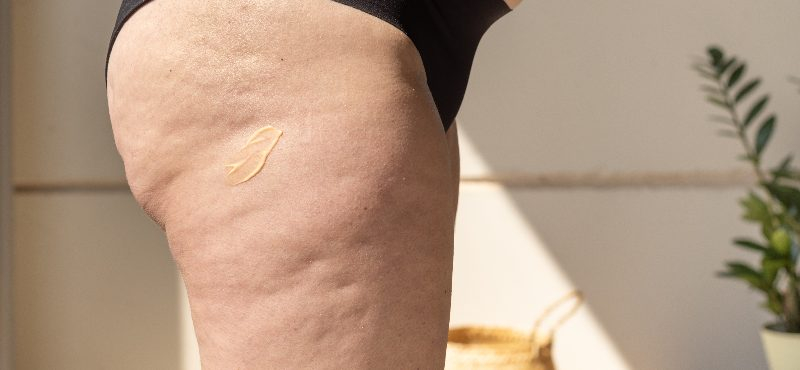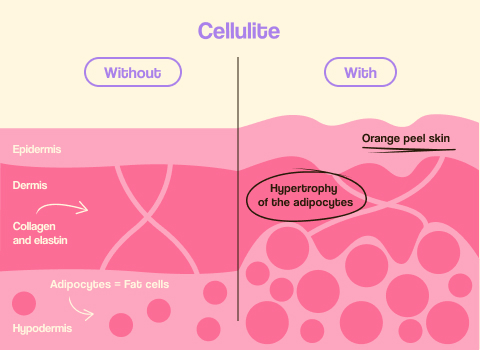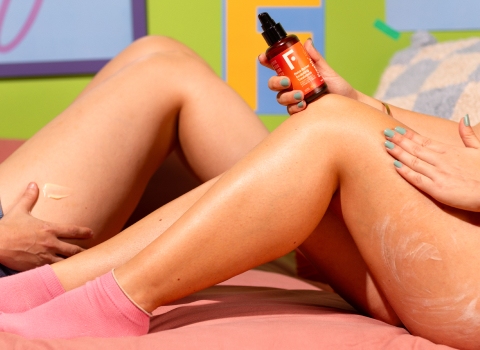Beta-Burner Sculpting Treatment
Anti-cellulite and slimming cream 100/200ml

Here are your essentials
for making it this far
What is cellulite and why does it appear?
What types of cellulite are there?
Did you know that 9 out of 10 women have cellulite? It's natural, you're not alone. We have a certain predisposition to its appearance in our thighs, buttocks, abdomen... And you may wonder, "Why?" Apparently, female skin is thinner than male skin (about 20%, according to dermatological studies), and subcutaneous fat is present in wider and higher vertical units (septa). This, together with low levels of androgens, can favor the predisposition to the appearance of cellulite in women. But "don't worry," there are ways to prevent it, and together with healthy lifestyle habits, you can successfully reduce it.
Stay tuned, and we'll tell you how. But first, let's see what cellulite is exactly and why it appears. The journey of cellulite begins with understanding it. If you know its causes, you can reduce it!
Cellulite is an excessive accumulation of fat, localized or generalized, caused by a hypertrophy of adipocytes, which grow in number and volume. Wait a moment, "what are adipocytes?" They are the cells that form adipose tissue. "What about adipose tissue?" It is the tissue where energy is stored in the form of fat. We could say that it is the storage place where reserves of energy are kept for our body to use the fat later to function.
It is important to clarify that fat is necessary for the functioning of our body. It is like having a hybrid car that runs on glucose and fat; without it, we could not perform many of the functions that we carry out every day. Imagine that glucose is our fridge, and fat is the freezer and pantry combined. The key is that our body generates, accumulates fat (energy), and consumes it in our daily life, and so on, like an assembly line.
But what happens if this process is altered? If something fails at some point in the assembly line, it gets stuck, goes faster than normal, a piece falls off... the rest of the chain will also be affected, right? Since everything is connected. In this case, in our body, there is an excess in the entry to the assembly line, and the fat requirements are lower than the entries, which ends up generating a disbalance.
What happens in our body is that accumulated fat (lipogenesis or formation of reserve fats) is not consumed at the rate it should be or a much larger amount than necessary is generated, leaving more accumulated fat. And if this "failure" persists over time, that accumulation will become increasingly greater, requiring an increase in the storage or space where that excess fat should be stored.
Therefore, it will end up being a space or part of our body that becomes increasingly larger, "what previously occupied a corner may end up disorganizing and occupying an entire warehouse." In that case, it will inevitably be more visible, right? The same thing happens with adipocytes, which, as they increase in number and volume (hypertrophy), motivate an increase in the retention of water, fats, and toxins, and end up generating those dimples or indentations in our skin, which we commonly know as "orange peel." Does that sound familiar?

Do you know about septa? They are a kind of column that groups fat cells (our friends, adipocytes) into compartments. These cells receive nutrition and oxygen through blood vessels. So far, so good, but when adipocyte hypertrophy occurs, the increase in the number and volume of these cells, as mentioned before, means that there is less and less space in these compartments, compressing blood vessels, lymphatics, and nerves.
This pressure triggers the alteration of the columns (septa) we mentioned earlier, which end up pushing up the dermis and epidermis, causing irregularities such as dimples and what is known as orange peel skin (the skin is no longer smooth).
In addition, it affects collagen and elastin fibers, which, when they see their space reduced by the push of the septa, translates into a loss of firmness and smoothness in the skin. When these processes continue to occur over time, they also end up affecting nerve endings, which is why discomfort or pain appears in the most severe degrees of cellulite.
We have seen the "problem" of fat storage and adipocyte hypertrophy, but in addition to this, there is a decrease in lipolysis. And you may be wondering, "what does that mean?" That our body, in addition to having problems with fat storage, reduces the breakdown of triglycerides into fatty acids, which, together with adipocyte hypertrophy, prevents the beta-oxidation of fats to release energy in the human body (producing large amounts of ATP). In other words, it cannot consume energy (fat) at the rate it should, but rather does so more slowly. Seen in this way, it seems like a disaster! But don't worry, because we can help our body function better. We'll tell you how in a moment. But first, did you know that there are 4 degrees of cellulite? Find out which one you have.
.jpg)
Now that we know what cellulite is and why it appears, you may be interested to know that there are 4 grades of cellulite. We help you identify yours so you can start your action plan and reduce your cellulite.
Do you already know which type of cellulite you have? The most common are grades 1 and 2, and in these cases it can be reduced with strength exercises, hydration, nutrition, and lipolytic or reducing creams.
How many times have you started a cellulite treatment? We've all been there, but at least now you know that to reduce it, the key is to improve the processes of fat storage (lipogenesis) and degradation of triglycerides to fatty acids in your body (lipolysis). And although cellulite is natural and common, it goes beyond that, and as we have seen, it is a health issue.

So now, let's go with the action plan to prevent, reduce and eliminate cellulite in 4 steps:
1- Nutrition
2- Liters and liters of water
Water is your best friend. Not only does water help you feel fuller, but it also helps with intestinal transit. It may be a sacrifice, but if you prioritize water over coffee or soda, you will have gained a large part of the way in your fight against cellulite.
3- Exercise, we make it easy for you!
You can set up a circuit of cardiovascular and functional exercises that will help you burn localized fat. A routine that, in fact, does not require a large space to maneuver... Just a minimum of time, dedicate 25 minutes a day.
You can do three or four rounds alternating 45 seconds of activity with 15 seconds of rest. Take note of the routine:
Combine them as your body asks so that it is as least fatiguing as possible.
4- Trustworthy cosmetics
Keep in mind what we mentioned earlier, what should you ask of your anti-cellulite cream? That it helps you improve the lipolytic activity of your body and is draining, to release the space of the "fat warehouse" and improve fluid retention, which translates into firmer and smoother skin.

Go from the miracle of anti-cellulite to the science of wellness. Say goodbye to orange peel skin effectively and healthily with natural ingredients thanks to Beta-Burner Sculpting Treatment, the reducing and firming cream, which breaks the molecular bonds of fatty acids to release energy and burn accumulated fat, that is, it helps you increase lipolysis and reduce cellulite, just what your skin needs! How does it do it? Thanks to an exceptional blend of 99.9% natural technology, composed of potent active ingredients such as Beta-Oxidation Active extracted from the creole clover, lipo algae, browning active, and caffeine. Visible results in 28 days!
Beloved by your skin. Beloved by science.
Freshly wants to tell you something! At Freshly we keep on learning every day how to make decisions that bring us closer to a better future. Sometimes we are called dreamers, but what we really have is an optimistic vision and clear path for reaching that tomorrow.
Would you like to join this adventure? If you're here, it's because you are a demanding person when it comes to taking care of your body and the planet. By subscribing to the newsletteryou will receive articles like this one to continue learning, as well as news and exclusive discounts. Are you up for it?